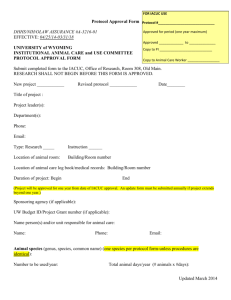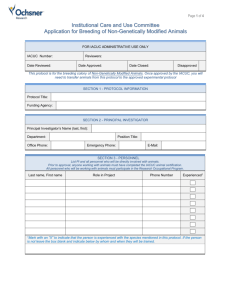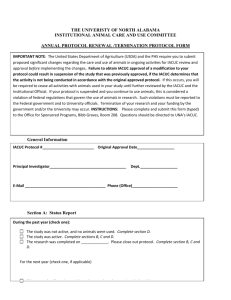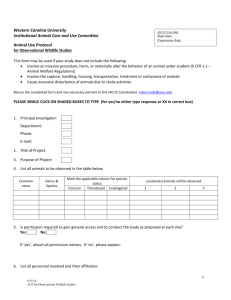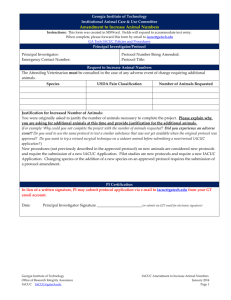June 2015 - University of Wyoming
advertisement
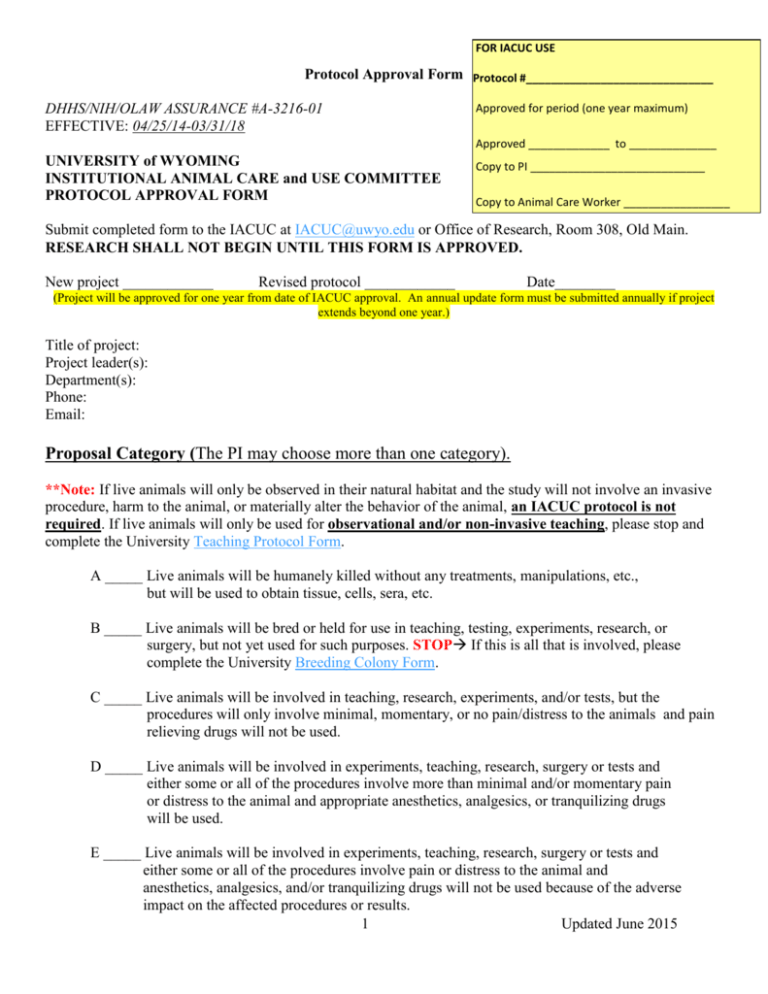
FOR IACUC USE Protocol Approval Form Protocol #______________________________ DHHS/NIH/OLAW ASSURANCE #A-3216-01 EFFECTIVE: 04/25/14-03/31/18 Approved for period (one year maximum) Approved _____________ to ______________ UNIVERSITY of WYOMING INSTITUTIONAL ANIMAL CARE and USE COMMITTEE PROTOCOL APPROVAL FORM Copy to PI ____________________________ Copy to Animal Care Worker _________________ Submit completed form to the IACUC at IACUC@uwyo.edu or Office of Research, Room 308, Old Main. RESEARCH SHALL NOT BEGIN UNTIL THIS FORM IS APPROVED. New project ____________ Revised protocol ____________ Date________ (Project will be approved for one year from date of IACUC approval. An annual update form must be submitted annually if project extends beyond one year.) Title of project: Project leader(s): Department(s): Phone: Email: Proposal Category (The PI may choose more than one category). **Note: If live animals will only be observed in their natural habitat and the study will not involve an invasive procedure, harm to the animal, or materially alter the behavior of the animal, an IACUC protocol is not required. If live animals will only be used for observational and/or non-invasive teaching, please stop and complete the University Teaching Protocol Form. A _____ Live animals will be humanely killed without any treatments, manipulations, etc., but will be used to obtain tissue, cells, sera, etc. B _____ Live animals will be bred or held for use in teaching, testing, experiments, research, or surgery, but not yet used for such purposes. STOP If this is all that is involved, please complete the University Breeding Colony Form. C _____ Live animals will be involved in teaching, research, experiments, and/or tests, but the procedures will only involve minimal, momentary, or no pain/distress to the animals and pain relieving drugs will not be used. D _____ Live animals will be involved in experiments, teaching, research, surgery or tests and either some or all of the procedures involve more than minimal and/or momentary pain or distress to the animal and appropriate anesthetics, analgesics, or tranquilizing drugs will be used. E _____ Live animals will be involved in experiments, teaching, research, surgery or tests and either some or all of the procedures involve pain or distress to the animal and anesthetics, analgesics, and/or tranquilizing drugs will not be used because of the adverse impact on the affected procedures or results. 1 Updated June 2015 Species Information Animal species (genus, species, common name) (one species per protocol form-unless procedures are identical): Number to be used/year: Total animal days/year (# animals x #days): Number to be used/project: Total animal days/project: Source of animals: Location Information Location of animal room: Building/Room number Location of animal care log book/medical records: Building/Room number Duration of project: Begin End Funding Information Sponsoring agency (if applicable): UW Budget ID/Project Grant number (if applicable): Name person(s) and/or unit responsible for animal care: Name: Phone: Email: 2 Updated June 2015 1) a. Purpose (in lay terms) b. Scientific objective(s) c. Potential for use of in vitro systems or computerized models instead of live animals i. Elaborate on current availability of animal data that could be used to predict outcomes ii. Elaborate on the uniqueness of the study such that the requirement for live animal research is necessary 2) Describe all procedures: Description should allow the IACUC to understand the experimental course of an animal from its entry into the experiment to the endpoint of the study. a. Overview of procedures (Reference citations for b-e) b. Type and duration of restraint c. Name and dose of anesthesia and/or tranquilizer (contact attending veterinarian) d. Surgical procedures i. pre-operative procedures ii. aseptic methods to be used: surgical attire iii. who will perform surgical procedures iv. where will surgical procedures be performed v. non-survival/survival surgery vi. justification if more than one surgical procedure per animal d. Post-surgical care i. Recovery facility ii. Name, dose, route of administration and regimen for analgesia; (investigate literature for pain management for species used; consult attending veterinarian) 3) Justification for species chosen (lowest possible species on phylogenetic scale) 4) Statistical justification for the specified number of animals (assistance to determine the appropriate number of animals per treatment) a. Justification for number of animals per experiment 3 Updated June 2015 b. Justification for number of experiments per year (as stated on page 2) c. Literature cited/reviewed for justification of number of animals proposed 5) Will animals be subjected to euthanasia? a. Method of euthanasia b. Drug and dosage c. If using drugs for euthanasia, describe disposal of animal remains. d. If animals will not be euthanized, describe plan for future use or other dispersal. 6) If the proposal category checked is D or E, then the experimental procedures may cause more than momentary or slight pain or distress and the PI must address the following: Provide a written narrative description, including methods and sources used in search, of how it was determined that alternatives to potentially painful or distressful procedures are not available. The Narrative should include at a minimum the following: a. b. c. d. A list of the databases (two or more) searched (see below); The terms used to search for alternatives to each painful or distressful procedure; Whether any alternatives were found and if so a description of each alternative; and If alternatives were found, an explanation of why the alternatives can’t be used in this study. Note: The purpose of this search is NOT to explain why the research does not duplicate other work. The purpose of this search is to show that there are no alternative to the potentially painful or distressful procedures outlined in this protocol. Including i: Literature cited; database references must include name of databases searched, the date of the search, period covered, and keywords used. For assistance with literature searches please see: http://libguides.uwyo.edu/AWA (which includes a video from a representative of the USDA) or contact the following University of Wyoming Librarians: Jenny Garcia at: jgarcia@uwyo.edu or David Kruger at: tseliot@uwyo.edu . And/Or ii: personal communications e. A minimum of two databases must be searched. i. Database 1: ii. Database 2: iii. Please add additional databases as necessary Please refer to Animal Welfare Act 9CFR Section 2.31 (d) (1) (ii) 7) Explain why this research does not involve unnecessary duplication of previous research or experiments 4 Updated June 2015 For assistance with literature searches please see: http://libguides.uwyo.edu/AWA (which includes a video from a representative of the USDA) or contact the following University of Wyoming Librarians: Jenny Garcia at: jgarcia@uwyo.edu or David Kruger at: tseliot@uwyo.edu . a. Please indicate date of search, name of databases, keywords used, and number of responses. A minimum of two databases must be searched. i. Database 1: ii. Database 2: iii. Please add additional databases as necessary b. Discuss relevant literature to justify why unnecessary duplication of previous research is not involved. The written narrative in this section should include at a minimum the following information: i. A list of the databases (two or more) searched (see above); ii. The terms used to search; iii. Whether any similar research was found and if so a description of that research; and iv. If similar research was found, an explanation of why this research is so different or why additional research is needed on the same topic that this research does not unnecessarily duplicate research that has already been done. Please refer to Animal Welfare Act 9CFR Section 2.31 (d) (1) (iii) 8) Training/experience documentation: Federal regulations require appropriate training and experience for all personnel involved in the care and use of animals. An up-to-date "Verification of Training for Animal Work" form must be on file in the Research Office for each person, including the P.I., involved in the care and use of animals to be used in this protocol. Verification of Training for Animal Work form: http://www.uwyo.edu/Research/forms.htm For PI(s) (name): For animal care worker/lab technician (name): Graduate student(s) (name): Others (name): attached ___ on file ___ date _____________ attached ___ on file ___ date _____________ attached ___ on file ___ date _____________ attached ___ on file ___ date _____________ Please list specific experience and/or qualifications of each animal care worker necessary to perform the specific techniques and procedures described in this protocol (such as surgery) if not included on the "Verification of Training for Animal Work" form attached or on file. Principal Investigator Assurance: "I have received a copy of the NIH Guide for the Care and Use of Laboratory Animals and/or The Guide for the Care and Use of Agricultural Animals in Agricultural Research and Teaching and will provide for the care, use and treatment of the animals used for the purpose described above accordingly. I will use procedures which will avoid or minimize discomfort, distress and pain to animals used in my research. I have considered alternatives to procedures that may cause more than momentary slight pain or distress to the animals. These studies do not unnecessarily duplicate previous experiments. I WILL INFORM THE ATTENDING VETERINARIAN (DAVID EVERTSON 745-7341) OR BACKUP VETERINARIAN ON STAFF AT ALPINE ANIMAL VETERINARY CLINIC IMMEDIATELY IF ANY PROBLEMS OCCUR, INCLUDING UNANTICIPATED PAIN OR DISTRESS, INJURY, MORBIDITY OR 5 Updated June 2015 MORTALITY. I will submit a revised protocol for IACUC approval before making any significant deviations from the approved project procedures occurs. I will submit an annual update for IACUC approval for continuation if this project extends beyond one year. I assure the IACUC that all persons involved in the care and use of animals related to this protocol have received the appropriate training and are qualified to perform the procedures described above." __________________________________ Principal Investigator .……………….Date REVIEWED AND APPROVED: __________________________________ Department Chairperson ……………Date _________________________________ Veterinary Officer ………………… Date ACTION BY THE ANIMAL CARE AND USE COMMITTEE: APPROVED _____________________________________ Chairperson, IACUC Date DISAPPROVED ________________________________________ Associate Vice President for Research Date 6 Updated June 2015
